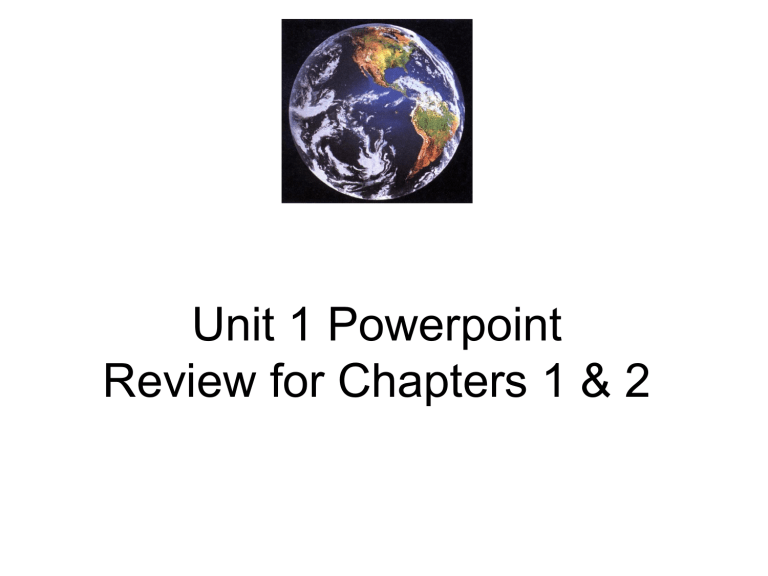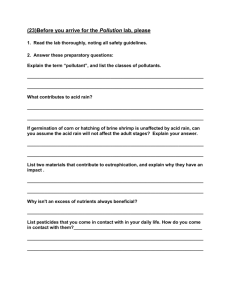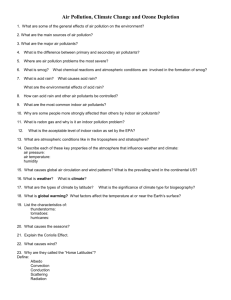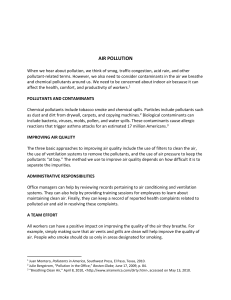PPT Review for Chapters 1&2

Unit 1 Powerpoint
Review for Chapters 1 & 2
Introduction
• Environment
– External conditions that affect living organisms
• Ecology
– Study of relationships between living organisms and their environment
• Environmental Science
– how nature works.
– how the environment effects us.
– how we effect the environment.
– how we can live more sustainably without degrading our life-support system.
Solar Capital and Earth Capital
• Solar Capital
– Energy from the sun
– Provides 99% of the energy used on earth
• Earth Capital
– Life-support and Economic
Services
• Environment
– Planet’s air, water, soil, wildlife, minerals, natural purification, recycling, pest control,…
Carrying Capacity
• The maximum number of organisms of a local, regional, or global environment can support over a specified period
• Variables
– Location
– Time
• Short term ~ seasonal changes
• Long-term ~global changes in factors such as climate
– Technology
Sustainability
• The ability of a specified system to survive and function over time
• $1,000,000
– 10% interest
– Live on up to $100,000 per year
• Examples: Sustainable earth, resource harvest, and society
• The steps to sustainability must be supported by sound science.
Linear Growth
• Quantity increases by a constant amount per unit of time
• 1,2,3,4,5, …
• 1,3,5,7,9, …
• When plotted on a graph, growth of money yields a fairly straight line sloping upward
120
100
80
60
40
20
0
1960 1980 2000 2020
Exponential Growth
• Growth yields a Jshaped curve
• Describes the human population problem that disturbs the environment today
3000
2500
2000
1500
1000
500
0
Population Growth
1970 1980 1990 2000 2010 2020
Rule of 70
• How long does it take to double?
– Resource use
– Population size
– Money in a savings account
• Rule of 70
– 70 divided by the percentage growth rate = doubling time in years
– 70 / 7% means it takes ten years to double
Economic Growth -
Key Terms
• Economic Growth
– Increase in the capacity to provide goods and services for people’s use
• Gross National
Product
– Measures economic growth in a country
• Gross Domestic
Product
– Market value in current dollars of all goods and services produced only within a country during one year
Economic Growth -
Key Terms
• More Developed Countries (MDC)
– Highly industrialized
– Average per capita GNP above $4000
• Less Developed Countries (LDC)
– Low to moderate industrialization
– Average per capita GNP below $4000
Economic Growth -
Key Terms
• Development
– Change from a society that is largely rural, agricultural, illiterate, poor and rapidly growing population
• Per Capita GNP
– GNP divided by the total population
– Shows one person’s slice of the economic pie
POPULATION GROWTH, ECONOMIC
GROWTH, AND ECONOMIC
DEVELOPMENT
• Economic growth provides people with more goods and services.
– Measured in gross domestic product
(GDP) and purchasing power parity (PPP).
• Economic development uses economic growth to improve living standards.
– The world’s countries economic status
(developed vs. developing) are based on their degree of industrialization and
GDP-PPP.
Wealth Gap
• The gap between the per capita GNP of the rich, middleincome and poor has widened since 1980
• More than 1 billion people survive on less than one dollar per day
Sustainable Development
• Assumes the right to use the earth’s resources and earth capital to meet needs
• It is our obligation to create sustainability
• Environmentally sustainable societies meets basic needs of its people in a just and equitable manner without degrading the natural capital that supplies these resources.
Resources
Renewable
Direct solar energy
Winds, tides, flowing water
Non-Renewable
Fossil fuels
Potentially
Renewable
Fresh air
Metallic minerals (iron, copper, aluminum)
Fresh water
Nonmetallic minerals (clay, sand, phosphates)
Fertile soil
Plants and animals
(biodiversity)
Biodiversity
• Genetic Diversity
– Variety in a genetic makeup among individuals within a single species
• Species Diversity
– Variety among the species or distinct types of living organisms found in different habitats of the planet
• Ecological Diversity
– Variety of forests, deserts, grasslands, streams, lakes, oceans, wetlands, and other communities
Environmental Degradation
Common Property
Resources
• Tragedy of the Commons
• Resources owned by none, but available to all users free of charge
• May convert potentially renewable resources into nonrenewable resources
Natural capital degradation
• The exponential increasing flow of material resources through the world’s economic systems depletes, degrades and pollutes the environment.
Figure 1-11
Nonrenewable Resources
• Nonrenewable/Exhaustible Resources
– Exist in a fixed quantity in the earth’s crust and can be used up
• Mineral
– Any hard, usually crystalline material that is formed naturally
• Reserves
– Known deposits from which a usable mineral can be profitably extracted at current prices
Nonrenewable Resources
• Recycling
– Collecting and reprocessing a resource into new products
• Reuse
– Using a resource over and over in the same form
ENVIRONMENTAL PROBLEMS:
CAUSES AND CONNECTIONS
• The major causes of environmental problems are:
– Population growth
– Wasteful resource use
– Poverty
– Poor environmental accounting
– Ecological ignorance
Poverty and Environmental
Problems
• 1 of 3 children under 5, suffer from severe malnutrition.
Figure 1-12 and 1-13
Our Ecological Footprint
• Humanity’s ecological footprint has exceeded earths ecological capacity.
Figure 1-7
Pollution
• Any addition to air, water, soil, or food that threatens the health, survival, or activities of humans or other living organisms
• Solid, liquid, or gaseous by-products or wastes
Point Source Pollutants
• From a single, identifiable sources
– Smokestack of a power plant
– Drainpipe of a meat-packing plant
– Exhaust pipe of an automobile
Nonpoint Source Pollutants
• Dispersed and often difficult to identify sources
– Runoff of fertilizers and pesticides
– Storm Drains (#1 source of oil spills in oceans)
Negativity of Pollutant
• Chemical Nature
– How active and harmful it is to living organisms
• Concentration
– Amount per unit volume or weight of air, water, soil or body weight
• Persistence
– Time it stays in the air, water, soil or body
Types of Pollutants
• Factors that determine the severity of a pollutant’s effects: chemical nature , concentration , and persistence .
• Pollutants are classified based on their persistence:
– Degradable pollutants
– Biodegradable pollutants
– Slowly degradable pollutants
– Nondegradable pollutants
Water Pollution
• Sediment
• Nutrient overload
• Toxic chemicals
• Infectious agents
• Oxygen depletion
• Pesticides
• Oil spills
• Excess heat
Air Pollution
• Global climate change
• Stratospheric ozone depletion
• Urban air pollution
• Acid deposition
• Outdoor pollutants
• Indoor pollutants
• Noise
Solution: Pollution cleanup
• Output Pollution
Cleanup
– Involves cleaning up pollutants after they have been produced
– Most expensive and time consuming
Solutions: Pollution Prevention
• Input Pollution Control or
Throughput Solution
– Slows or eliminates the production of pollutants, often by switching to less harmful chemicals or processes
• Four R’s
– Reduce, reuse, refuse, recycle
Biodiversity Depletion
• Habitat destruction
• Habitat degradation
• Extinction
Food Supply Problems
• Overgrazing
• Farmland loss and degradation
• Wetlands loss and degradation
• Overfishing
• Coastal pollution
• Soil erosion
• Soil salinization
• Soil waterlogging
• Water shortages
• Groundwater depletion
• Loss of biodiversity
• Poor nutrition
Agricultural Revolution
• Agricultural
Revolution
– Cultural shift that began in several regions of the world
– Involved a gradual move from a lifestyle based on nomadic hunting
• Agroforestry
– Planting a mixture of food crops and tree crops
Agricultural Revolution
• Slash-and-burn
– Cutting down trees and other vegetation and then burning the underbrush to clear small patches of land
• Subsistence Farming
– Family grew only enough food to feed itself.
What Is Science?
• Science is a pursuit of knowledge about how the world works
• Scientific data is collected by making observations and taking measurements
• Observations involve the five senses, and help answer questions or problems
Observation
• Qualitative
– of, relating to, or involving quality or kind
– ie.: red, hot, burns quickly, etc.
• Quantitative
– of, relating to, or involving the measurement of quantity or amount
– ie.: 350 degrees
Celsius, 5 inches, etc.
Vocabulary
• Experiment
– A procedure to study a phenomenon under known conditions
– Must have a Control
• Hypotheses
– A possible explanation of something observed in nature.
• Model
– An approximate representation of a system being studied.
Theory and Law
• Scientific Theory
– A hypothesis that has been supported by multiple scientists’ experiments in multiple locations
• A Scientific Law
– a description of what we find happening in nature over and over again in a certain way
Scientific Laws
• Law of Conservation of Matter
– Matter can be changed from one form to another, but never created or destroyed.
• Atomic Theory of Matter
– All matter is made of atoms which cannot be destroyed, created, or subdivided.
Accuracy and Precision
• Accuracy
– The extent to which a measurement agrees with the accepted or correct value for that quantity.
• Precision
– A measure of reproducibility, or how closely a series of measurements of the same quantity agrees with one another.
Reasoning
• Inductive Reasoning
– Uses observations and facts to arrive at hypotheses
– All mammals breathe oxygen.
• Deductive Reasoning
– Uses logic to arrive at a specific conclusion based on a generalization
– All birds have feathers, Eagles are birds, therefore All eagles have feathers.
Scientific Methods
• What is the question to be answered?
• What relevant facts and data are known?
• What new data should be collected?
• After collection, can it be used to make a law?
• What hypothesis can be invented to explain this? How can it become a theory?
Experiments
• Variables are what affect processes in the experiment.
• Controlled experiments have only one variable
• Experimental group gets the variable
• Control group does not have the variable
– Placebo is a harmless pill that resembles the pill being tested.
– In double blind experiments, neither the patient nor the doctors know who is the control or experiment group.
Systems
• A system is a set of components that function and interact in some regular and predictable manner
• Human body, a river, an economy, The Earth !
– The earth is a closed system for matter and an open system for energy
Feedback Loops
• A feedback loop occurs when an output of a system is fed back as an input (two kinds)
– Positive loops are runaway cycles where a change in a certain direction causes further change in the same direction
– Negative loops occur when a change in a certain direction leads to a lessening of that change
Resource Consumption and
Environmental Problems
• Underconsumption
• Overconsumption
– Affluenza: unsustainable addiction to overconsumption and materialism.
• The pH (potential of Hydrogen) is the concentration of hydrogen ions in one liter of solution.
Figure 2-5
Compounds and Chemical
Formulas
• Chemical formulas are shorthand ways to show the atoms and ions in a chemical compound.
– Combining Hydrogen ions (H + ) and Hydroxide ions (OH ) makes the compound H
2
O
(dihydrogen oxide, a.k.a. water).
– Combining Sodium ions
(Na + ) and Chloride ions
(Cl ) makes the compound NaCl (sodium chloride a.k.a. salt).
Cells: The Fundamental Units of
• Cells are the basic
Life
structural and functional units of all forms of life.
– Prokaryotic cells
(bacteria) lack a distinct nucleus.
– Eukaryotic cells (plants and animals) have a distinct nucleus.
Figure 2-6
Macromolecules, DNA, Genes and Chromosomes
• Large, complex organic molecules
(macromolecules) make up the basic molecular units found in living organisms.
– Complex carbohydrates
– Proteins
– Nucleic acids
– Lipids
Figure 2-7
Matter Quality
• Matter can be classified as having high or low quality depending on how useful it is to us as a resource.
– High quality matter is concentrated and easily extracted.
– low quality matter is more widely dispersed and more difficult to extract.
Figure 2-8
CHANGES IN MATTER
• Matter can change from one physical form to another or change its chemical composition.
– When a physical or chemical change occurs, no atoms are created or destroyed.
• Law of conservation of matter.
– Physical change maintains original chemical composition.
– Chemical change involves a chemical reaction which changes the arrangement of the elements or compounds involved.
• Chemical equations are used to represent the reaction.
Chemical Change
• Energy is given off during the reaction as a product.
ENERGY
• Energy is the ability to do work and transfer heat.
– Kinetic energy – energy in motion
• heat, electromagnetic radiation
– Potential energy – stored for possible use
• batteries, glucose molecules
ENERGY LAWS: TWO RULES
WE CANNOT BREAK
• The first law of thermodynamics: we cannot create or destroy energy.
– We can change energy from one form to another.
• The second law of thermodynamics: energy quality always decreases.
– When energy changes from one form to another, it is always degraded to a more dispersed form.
– Energy efficiency is a measure of how much useful work is accomplished before it changes to its next form.
Sustainable Low-Throughput
Economies: Learning from Nature
• Matter-Recycling-and-
Reuse Economies:
Working in Circles
– Mimics nature by recycling and reusing, thus reducing pollutants and waste.
– It is not sustainable for growing populations.






